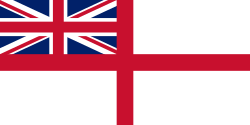History
The Royal Navy established a Red Sea formation as early as 1846, administered by the Royal Indian Navy. [1] [2] It was subordinate to the Commander-in-Chief, East Indies until 1883, when it became part of the Mediterranean Fleet. In 1914 the station came under command of the Commander-in-Chief Mediterranean Fleet until the end of the war. Following the war the Red Sea was reabsorbed back under the Commander-in-Chief, East Indies.
During the East African Campaign, the Red Sea Force fought the Italians. British code-breakers of the Government Code and Cypher School (GC&CS) at Bletchley Park in the UK, deciphered Italian orders of 19 May 1940, coded using C38m machines, secretly to mobilise the army and air force in East Africa. Merchant traffic was stopped by the British on 24 May, pending the introduction of a convoy system. The Senior Naval Officer Red Sea, Rear-Admiral Murray, operational at Aden since April with the light cruisers HMS Liverpool and HMAS Hobart (Liverpool was replaced by HMS Leander), was reinforced by the anti-aircraft cruiser HMS Carlisle, which sailed south with Convoy BS 4, the 28th Destroyer Flotilla comprising HMS Khartoum, Kimberley, Kingston and Kandahar and three sloops from the Mediterranean. The force was to conduct a blockade Italian East Africa (Operation Begum), attack the Red Sea Flotilla and protect the sea lanes from Aden to Suez.
On 21 October 1941 the Mediterranean Fleet's responsibilities were extended to include the Red Sea and Aden, including the Gulf of Aden. The Mediterranean Fleet thus took over the Red Sea Division of the Red Sea Station, which was located between the Gulf of Aden and the Suez Canal, excluding Suez Port. [4] Rear-Admiral Ronald Hallifax took command as Flag Officer, Red Sea (FORS). [4] Three weeks later the responsibilities were adjusted once more. On 14 November 1941 the Senior Naval Officer-in-Charge, Suez, who was based at Port Tawfik (Suez Port) was placed under the command of Rear Admiral Hallifax.
Over a hundred kilometres to the north, halfway up the Suez Canal, the Senior British Naval Officer, Suez Canal Area, based at Ismailia, remained responsible for all British naval policy questions in regards to the Suez Canal Company. [4]
In January 1944 the station was transferred back from the Mediterranean Fleet to C-in-C East Indies.
Flag Officer Commanding, Red Sea and Canal Area
Commodore Young-Jamieson's broad pennant was seemingly borne in HMS Stag (shore establishment), which was the name used for the base for British naval personnel in Egypt. First established at Port Said, it was commissioned on 8 January 1940. There were outposts at Adabya, Kabrit, Ismailia, Generiffa, Port Tewfik. HMS Stag was paid off in May 1949.
HMS Euphrates at Basra seemingly reported to Flag Officer, Red Sea and Canal Area, from its establishment in 1942.
This page is based on this
Wikipedia article Text is available under the
CC BY-SA 4.0 license; additional terms may apply.
Images, videos and audio are available under their respective licenses.
